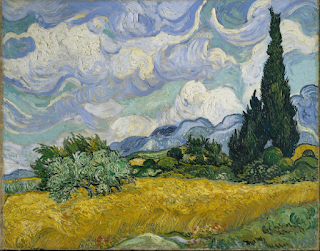 |
| Sunrise at Palm Springs, Photo by Judy Patterson |
Whether it is an outdoor photograph, plein air painting, or a made up scene, landscapes typically depict broad views of nature. This style of realism is often referred to as naturalism. They can be representational, impressionistic, or abstract. Probably the biggest challenge for an artist is painting the atmosphere. The 2017 "Seeing Nature: Landscape Masterworks from the Paul G. Allen Family Collection" shown at the Seattle Art Museum was a spectacular display of 39 assorted works celebrating the art of landscape.

 |
| Lake Cavanaugh, Mt. Vernon, WA Photo by Karynne Patterson |
I found these two paintings (left by Terry Suave and right by Paul Grimm) and thought they were great examples of desert scenes like the one photographed above. The vegetation is similar to the decorative cactus and plantings of Palm Desert.
I like the muted colors of this painting of subtly blooming cactus, entitled "Landscape no 25 (Blooming Cactus Palm Springs)" by artist Daniel Clarke.
For this post, I will share landscape photographs (some by my family) as well as some of my personal favorites. Classic realistic or naturalistic works will include works by Thomas Cole, John Constable, Jean Francois Millet, and J. M. W. Turner.
 |
| Wivenhoe Park, Essex (1816), John Constable |
 |
| Scene from "The Last of the Mohicans," Cora Kneeling at the Feet of Tamenund, Thomas Cole |
Viewed this Turner in 2017 at the National Gallery in London.
 |
| "The Fighting Temeraire" (1839), Turner |
And this VanGogh in 2017 at the Scottish National Gallery in Edinburgh, Scotland.
 |
| "Les Oliviers" (1889), Van Gogh |
 |
| Wheat Field With Cypresses (1889), Van Gogh |
Many of my favorite Impressionists also painted landscapes. Some of my colleagues from the Black Diamond Arts Alliance like to paint outdoors (plein air). Such methods were common to painters such as Van Gogh, although his friend, Gauguin criticized him for it and wondered why he refused to generate his own ideas from his imagination. I argue that his choice of colors came directly from his imagination! Pastel painters, like the Impressionists, paint 'outside the blue box' and often use other than the traditional blue and white sky colors in their paintings.
 |
| "Mont Sainte-Victoire Seen from the Bibemus Quarry", Cezanne |
On our road trip to California, I was on the lookout for cypress trees. I believe the California versions are pointier than those from Van Gogh's home of Arles, France. Over 20 years ago, I would borrow a small petrified potted version of a cypress tree as a visual aid for students when I would teach about Van Gogh.
Anyway, I will share my favorite landscapes from Paul Cezanne, Camille Pissarro, Alfred Sisley, and of course, Vincent Van Gogh.
These two paintings -- Pissarro's (left) and Millet"s (right) -- are quite different though I naturally gravitate to the brighter, more colorful Pissarro version. However, I have learned to love Millet's peasant painting over the years for its technical beauty. Van Gogh copied many of Millet's works and colorized them much as Pissarro had done.
 |
| "Potato Harvest", Pissarro (1893) |
 |
| "The Gleaners", Millet (1857) |
 |
| "Effect of Snow at Argenteuil", Sisley (1874) |
One of the most difficult landscapes to paint is a snow scene. I recall attempting this in my high school Art Major class and was not very successful. Of course, Sisley mastered it superbly!

While in Palm Springs there were works by Alexander Calder who in addition to making mobiles had quite a large body of abstract expressionist works using black and white and the primary colors. I have long admired Joan Miro, who used a similar color palette. This Calder painting was hanging behind the information desk at the Palm Springs Art Museum. Not sure if it is a landscape although I have seen spiral shapes in other 'wave' paintings.

I find this reddish landscape to be somewhat similar to Frankenthaler's "Carousel" although hers (right) may not actually be a landscape.
.



No comments:
Post a Comment
Do you have a favorite art movement or style? What's your favorite abstract artwork?